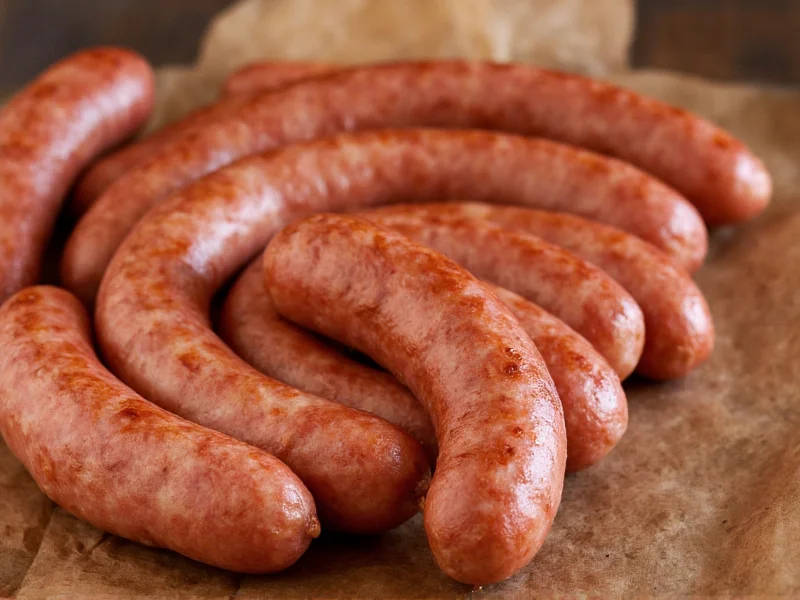Understanding Hungarian Sausage: A Culinary Tradition
When exploring Hungarian cuisine, few elements capture the essence of the country's food culture quite like its renowned sausages. Hungarian kolbász represents more than just a meat product—it's a culinary tradition deeply embedded in Hungarian heritage. Unlike many commercial sausages found worldwide, authentic Hungarian varieties maintain strict preparation standards that have been passed down through generations.
Historical Roots of Hungarian Sausage Making
The art of Hungarian sausage making dates back to medieval times when preservation techniques were essential for survival through harsh winters. Hungarian farmers developed smoking and curing methods that not only preserved meat but also created distinctive flavors. The introduction of paprika from the New World in the 16th century revolutionized Hungarian sausage production, becoming the defining ingredient that sets Hungarian varieties apart from other European sausages.
Key Characteristics of Authentic Hungarian Sausage
What makes Hungarian sausage unique among global sausage varieties? Several defining characteristics set authentic kolbász apart:
- Paprika dominance—Both sweet and hot varieties use generous amounts of high-quality Hungarian paprika
- Traditional smoking process—Using specific woods like beech or oak for authentic flavor
- Meat composition—Primarily high-grade pork with specific fat-to-lean ratios
- Natural casings—Traditionally using hog or sheep casings rather than synthetic alternatives
- No fillers—Authentic versions contain no breadcrumbs, soy, or other extenders
Major Types of Hungarian Sausage
Hungarian sausage isn't a single product but encompasses several distinct varieties, each with specific preparation methods and regional significance. Understanding these differences helps appreciate the diversity within Hungarian sausage tradition.
| Type | Characteristics | Preparation Method | Best Uses |
|---|---|---|---|
| Csabai Kolbász | Spicy, coarsely ground, distinctive spiral shape | Slow-smoked over beech wood, air-dried | Traditional cold cuts, sandwiches |
| Debreceni Kolbász | Milder than Csabai, finer grind, deep red color | Hot smoked, shorter drying period | Cooking in stews, soups, frying |
| Téliszalámi (Winter Sausage) | Fermented, air-dried, complex flavor profile | Extended fermentation and drying process | Charcuterie boards, sliced thin |
| Hurka | Not smoked, liver or meat-based | Boiled sausage, often with rice | Served hot with mustard |
The Art of Traditional Hungarian Sausage Making
Authentic Hungarian sausage production follows time-honored methods that contribute to its distinctive flavor and texture. The process begins with carefully selected pork—typically from specific cuts with the right fat content. Butchers grind the meat to precise specifications, then mix in paprika, garlic, and other spices before stuffing into natural casings.
The smoking process represents perhaps the most crucial step. Traditional Hungarian sausage makers use specific woods and carefully controlled temperatures during smoking. Many authentic producers still use smokehouses where temperature and humidity are monitored manually, as modern industrial methods often fail to replicate the complex flavor development achieved through traditional techniques.
Distinguishing Authentic Hungarian Sausage from Imitations
With the growing popularity of Hungarian cuisine, many products labeled as "Hungarian sausage" lack authentic characteristics. True Hungarian kolbász should feature:
- A deep red color from quality paprika, not artificial coloring
- Visible meat texture rather than homogeneous paste
- A balanced paprika flavor that's distinctive but not overwhelming
- No water or fillers listed in ingredients
- Traditional smoking aroma rather than liquid smoke flavoring
When shopping for genuine Hungarian sausage, look for products that specify traditional preparation methods and Hungarian paprika as a primary ingredient. Many authentic Hungarian sausages carry protected geographical indication (PGI) status, particularly those produced in specific regions like Csaba.
Culinary Applications of Hungarian Sausage
Hungarian sausage features prominently in traditional dishes but also adapts well to contemporary cooking. The most classic preparation involves slicing and pan-frying debreceni kolbász until crispy, serving with mustard and bread. Csabai sausage typically appears as part of cold cut platters, while téliszalámi gets sliced paper-thin for charcuterie boards.
Chefs increasingly incorporate Hungarian sausage into innovative dishes while respecting its traditional flavor profile. Popular applications include:
- Adding diced debreceni to bean soups and stews
- Using as pizza topping with caramelized onions
- Incorporating into pasta sauces for depth of flavor
- Grilling whole links as main course with roasted vegetables
- Chopping finely for savory pastries and strudels
Storage and Handling Guidelines
Proper storage maintains the quality and safety of Hungarian sausage. Unopened smoked varieties can last several weeks refrigerated, while dried sausages like téliszalámi keep for months when stored properly. Once opened, consume within 3-5 days. For extended storage, freeze sausage in airtight packaging for up to 3 months.
When cooking Hungarian sausage, avoid high heat that might cause the casing to burst. Instead, cook over medium heat, turning frequently until heated through. Many traditional Hungarian cooks recommend briefly boiling sausage before finishing with pan-frying to ensure even cooking without drying out the meat.
Common Misconceptions About Hungarian Sausage
Several misconceptions surround Hungarian sausage that deserve clarification. First, not all Hungarian sausages are extremely spicy—many traditional varieties use sweet paprika. Second, authentic Hungarian sausage contains no fillers like breadcrumbs, which distinguishes it from many commercial sausages. Third, while paprika defines Hungarian sausage, garlic plays an equally important supporting role in the flavor profile.
Another common misunderstanding involves the difference between Hungarian and Polish sausages. While both feature in Central European cuisine, Polish kielbasa typically uses different spices (like marjoram) and preparation methods, resulting in distinct flavor profiles despite superficial similarities.











 浙公网安备
33010002000092号
浙公网安备
33010002000092号 浙B2-20120091-4
浙B2-20120091-4